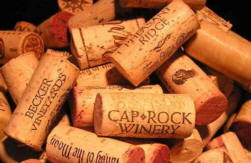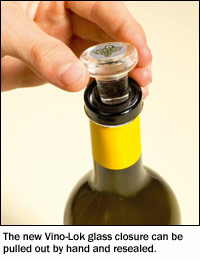
|
that plug of bark! ......is the Cork Age over?
By: Thomas M. Ciesla |
|
| |

|
Is there a screw-cap in your future? In the October issue of Food & Wine magazine, Robert Parker offered 12 bold predictions regarding changes in the world of wine. In prediction number five, Parker states, I believe wines bottled with corks will be in the minority by 2015. Stelvin, the screw-cap of choice will become the standard for the majority of the world's wine. Parker isn't alone in his belief, Robert Smiley, a University of California wine economist also feels that in 10 years we won't be using corks, It's not a quality solution to a long-term problem. Large hurdles still remain in separating the look of wine packaging from the inferred quality of the wine inside. There's also the power of tradition and human resistance to change. We like the sound of the cork popping, and we like the ritual of using the corkscrew. Some wine retailers the other part of the acceptance equation are not fans of the screw-cap, they think they cheapen the look of the wine and remove the mystery afforded with a cork. Building support for the screw-cap is like building a four-legged chair, all the legs: winemaker, retailer, restauranteur, and consumer must work together.
A Texas Twist? And what of Texas winemakers, are they ready to do the twist? Well, maybe someday but not in the near future. For some Texas winemakers, like Caris Turpen of Lightcatcher Winery, tradition and presentation are important, We believe corks lend a specific and irreplaceable aspect of 'the culture of the table'. We think screw caps fit a certain type of wine style and might gain more recognition over the coming years, but we will not switch to them. Besides the aesthetic issues of a screw-cap is the question of wine quality; it's too soon to know if wine will be able to age well with this type of closure. Edward Manigold, owner/winemaker at Spicewood Vineyards shares that concern, The major issues for screw caps are how long will the wine last and what is it's ageing potential? Besides ageability, it's important to point out that screw-caps have their own problems. A screw-cap leaks more readily than a cork, and the metal caps can get banged up, sometimes to a point where the bottle can't be opened. In addition, screw-caps can be sabotaged by simply stabbing it with a knife. As California wineries experiment with screw-caps, Texas wine makers are likely to take and wait-and-see approach. Tim Dodd of the Texas Wine Marketing Research Institute knows of no major programs within the Texas wine industry to convert to screw-caps, though he believes a few of the larger wineries, are considering the closure. Ultimately, making the switch to the screw-cap closure is a financial decision. In Texas, where most wineries are small, spending $75,000 on a specialized bottling line for a portion of your product can be prohibitive. Raymond Haak, owner/winemaker of Haak Vineyards sums up the cautious approach to the closure, My guess the reason is that it takes big money to install new bottling machines for screw-caps and that eliminates most of the Texas wineries. Robert Parker's prediction may be realized by the winemakers 'Down-Under', but for the Texas wine industry, Raymond Haak's crystal ball is probably more accurate. And what about the grandfather of the screw-cap Gallo Winery? They're studying the issue, but have no immediate plans to use the closure on their premium wines. How's that for irony? |

